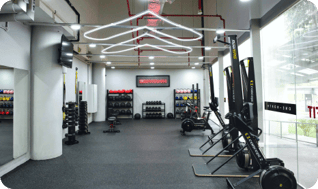Cancer survivors often present with muscle weakness, fatigue, limitation of movement, lymphedema, and pain. The National Cancer Institute explains that exercise in general, is beneficial to cancer patients undergoing treatment and in recovery. However, many forms of exercise may be too high-impact for those suffering from fatigue and muscle weakness as a side effect. What makes Pilates such a great fit for Cancer rehab is that it is low-impact and features exercises that can be easily modified to suit a patient’s needs and abilities. Pilates exercises allow this special population to lie supine and relaxed on the Reformer or Cadillac and reintroduce movement at any stage of recovery.
Pilates is a viable option for cancer patients because the nature of the program works the body from the inside out. It is a true Mind-Body application. Joe Pilates identified his work as “Contrology” - meaning the mind must control the action of the muscles. He often said, “Your muscles must obey your will.” For the muscles to react effectively and functionally, they need to be triggered by the correct neuro response. The brain signals the muscle to react, and then the muscle responds and moves. Pilates involves activity that is initiated by the brain and the breath and activity accesses the core in the process. When the core is the foundation of the movement, the extremities move more efficiently and movement becomes more fluid and centered. The body begins to move the way it was intended to move. Pilates exercises are Movements that Matter: Conscious movement that results in Sub-Conscious results. Pilates is movement that heals.
Breathwork And Its Contribution To Healing
Our autonomic nervous system tends to be “sympathetic” dominant, which means that it's easily excited. With mindful breathing, we can deliberately shift our nervous systems so that our parasympathetic system is dominant for healing in our body. The Breath is an integral part of the Pilates movement. It is what gives us life. Breathwork in Pilates is diaphragmatic in nature. Our diaphragm, one of the largest muscles in our body, is located below the lungs and heart. When we take shallow breaths or breathe through our mouths, we don't engage the diaphragm, and it doesn't move. When we breathe deeply through our noses, our diaphragm pushes down, and with each inhalation, it massages our gastrointestinal tract and stimulates strong digestive flow so our bodies can remove mucus, phlegm, fat, and inflammation from the inner walls of our organs.
Source: Freepik
Diaphragmatic breathing, via research, has been shown to positively improve immune function, decrease hypertension and stress-related disorders, and increase oxygen uptake and blood circulation. Oxygen is one of nature's miracle drugs, and when our diaphragm is strong, we can move oxygen deeper into our muscles, tissues, and nervous system. Developing the diaphragm muscle also gives us tremendous lower back support and helps to keep our spines straight, which takes the strain off the muscles in our trunk, abdomen, hips, and buttocks.
I always tell my clients NOT to hold their breath when they are doing Pilates exercises and try to breathe slower and longer as shallow breathing is an indicator of stress. To help you elongate your breath, I will place my hands around the side of your ribcage to encourage you to breathe into my hands at a slow count of 1, 2, 3 and into the circle of your ribcage as if you are inflating a balloon. As our diaphragm muscle gets stronger, our rib cage becomes more elastic, allowing our lungs to expand and take in an enormous amount of oxygen. Combining a super-strong diaphragm muscle and an elastic rib cage adds up to a boatload of energy and vitality.
Corrects Postural Deviation & Muscle Imbalances
One of the most important, if not THE most important, part of recovery from the debilitating side effects of cancer surgery and treatment is correcting postural deviations that are the result of muscle imbalances. Because the body is interconnected, it affects the entire structure when one part of the body is out of alignment. When you have poor posture, your bones are not aligned correctly, putting strain on muscles, ligaments, and joints. Poor posture can also impact the internal organs, affecting how they function and even how you breathe. Imbalances and misalignment can cause fatigue and, eventually, pain in the neck, back, hips, or other body parts. If you are recovering from cancer from surgery, poor posture can affect the natural healing process. Therefore, emphasising the importance of muscle balancing is paramount to your recovery process.
Doing a thorough postural assessment and functional tests is essential for me to assess your muscle imbalances before individualising a corrective exercise plan. From there, I can determine which areas need to be stretched to relieve tightness and spasms and which areas need to be strengthened to create a counterbalance. I also need to know your cancer history beforehand (eg. How many lymph nodes were removed, any radiation done, any peripheral neuropathy from chemotherapy) to design a safe and effective exercise plan to help you find success in your progress in achieving muscular strength, flexibility, and balance.
One of the common postural deviations I observed following a breast cancer mastectomy, reconstruction, radiation, and/or lymph node dissection is forward head and rounded shoulders (upper cross syndrome). I recommend stretches to open up the chest and improve the range of motion and flexibility in the shoulder and chest areas. Followed by exercises to restore strength to the shoulder and arm muscles and to “train” the affected side to better handle the lymph flow.
Provided you have medical clearance from your doctor to start exercising, early practice after surgery with a Cancer Exercise Specialist improves functional outcomes and significant improvements in all aspects affecting the quality of life.
Core Strength
The muscles involved in building core strength include your upper postural muscles, your abdominals, your pelvic floor, and your back muscles. The benefits of a strong core are to create a strong foundation and ‘house’ the power that the extremities can tap into. Our skeletal system is our structure; however, it is our muscles that ‘feel’ their way to allow the body to move. A strong core allows the muscles to move the body but, more importantly, allows the body to remain aligned correctly. This is what Pilates is best known for — enhancing the core muscles to enable one to capture and maintain solid body alignment and integrity of the spine.
I would teach core exercises that can be done on the mat and encourage you to extend your practice beyond the Pilates studio and into your home environment. After all, building core strength requires time, dedication, and perseverance!
References:
- Cancer Exercise Training Institute
- Life With Breath IQ + EQ = NEW YOU by Ed Harrold. Retrieved from Part One, Chapter Two


.png?width=301&height=187&name=Website%20Navigation%20Images%20(3).png)

-1.jpg?width=1984&height=1196&name=UFIT%20Club%20Street%20Front%20(4)-1.jpg)





.webp?width=300&name=What%20Makes%20Pilates%20A%20Great%20Fit%20For%20Cancer%20Rehabilitation%20-%20Blog%20banner%20image%20(1).webp)